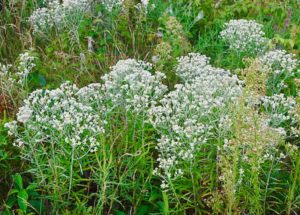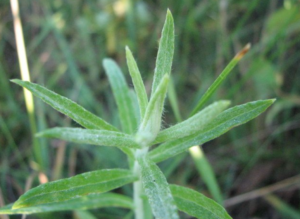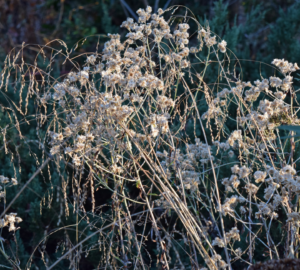Common Name: Sweet Everlasting, Cudweed, Rabbit Tobacco, Field Balsam
Specific Name: Gnaphalium obtusifolium
Known Occurrence at Taylor Point:
Map Areas: Beach 1A, Beach 1C
Category: Native, Herbaceous Plant

Ecological Considerations:
Gnaphalium obtusifolium, commonly known as Sweet Everlasting, is an herbaceous plant that primarily grows as an annual. In some cases it may behave as a biennial, growing a low rosette of fuzzy leaves the first growing season and then blooming in the second season. It generally measures one to two in height and is most easily identified by its branching cluster of small, white or pale yellow, tubular flower heads. What appears to be several layers of many tiny white petals on the egg-shaped flower are actually bracts; the disc flower parts are indistinct, seen at the tip and are yellow to brownish. The bracts spread out and fall off as the seed ripens. The flower blooms in late summer into autumn. The light colored bloom of the sweet everlasting forms a tightly packed, rounded-cylindrical structure atop the terminal shoot of a slender, green, cottony stem. Flowers are pointed at the tip, arranged in their terminal clusters, they do not open until in seed. The fruit is a dry seed with a tuft of light brown hair that serves to carry it off in the wind. When in bloom, the flowers have a pleasant, distinctive aroma reminiscent of maple syrup or vanilla.
The leaves are long, needle-like, and are covered in a whitish down on their underside. The stems and the base of the bracts also are covered with dense white woolly hairs. The narrow elliptical leaves of the Sweet Everlasting are aromatic when crushed.
Sweet Everlasting prefers full sun and is most often found along roadsides, in open disturbed areas and in fields and meadows.
Map areas where this plant can be used for revegetation:
Propagation Mechanisms/Strategies for Encouraging its Establishment:
While they live only for a season, Sweet Everlasting plants produce large quantities of seed and when this seed finds suitable conditions, it germinates and grows to bloom again.
Best Planting Practices/Options and Pros and Cons of Options:
Key Issues Regarding its Ecology:
Associated Ecological Benefits:
Sweet Everlasting flowers attract butterflies and other pollinators. The flowers are insect-pollinated, most commonly by short-tongued bees, flies and wasps. The plant also serves as a larval host for the American lady (Vanessa virginiensis) and painted lady (V. cardui) butterflies.
Availability of Locally Sourced Seeds and Plants:
Case Studies of Native Plant Establishment Efforts/Lessons Learned:
Additional Photos:



Sources cited:
Brandeis
North Carolina State
Go Botany
Critsite
Houzz
Minnesota Wildflowers
Key Words:
Gnaphalium obtusifolium
Sweet Everlasting
Beach 1-A
Beach 1-C
